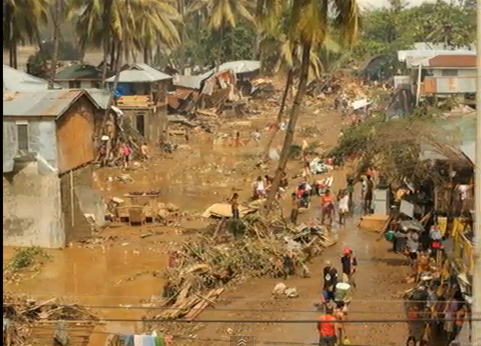Extreme Weather: Flash flooding kills 500, displaces 100,000 in the Philippines

Tropical Storm Washi dumped on the island of Mindanao more than a month of average rains in just 12 hours. According to weather forecaster Leny Ruiz the records show that storms that follow Washi's track come only once in about 12 years. Officials claim it was one of the most destructive calamities in southern Philippines in recent years and struck areas not used to severe flooding. River flooding was worsened by the high tide.
The storm has left many areas in northern Mindanao, particularly in Cagayan de Oro city without electricity and with disruptions to the cities water supply for the population of more than 500,000 people. There are unidentified bodies piled up in morgues, with a shortage of coffins and body bags.
Philippine Red Cross Chairman Richard J.Gordon said that Mindanao is not usually a typhoon prone area and residents were caught unprepared, mostly shocked by the flash floods that swept away their belongings and source of livelihood such as crops and livestock.
According to the Red Cross the worst hit areas were: Cagayan De Oro City with 215 dead and Iligan with 195. Other areas with casualties were Bukidnon, 47; Compostela Valley 5; Zamboanga Del Norte, 3; Lanao del Norte, 9; Surigao Del Sur; 1 and Dumaguete, Negros Oriental, 22. Vicente Emano, the mayor of Cagayan de Oro, said "I believe the city death toll would eventually reach about 500," in a telephone interview on Manila radio station DZMM.
A nine-man team of police and volunteer rescuers for a rescue mission in the flooded Libona township were caught by a flashflood as they were about to cross the Bubunawan River. One policeman was washed away in the incident.
Extreme weather and climate change
In all the reports of this extreme weather disaster there is no mention of climate change. Indeed, the Philippines region experiences up to 19-20 tropical cyclones or typhoons each year with 6-9 making landfall on a regular basis, so this cyclone was just another tropical storm.
Except it dumped an extreme amount of torrential rain over 12 hours.
Was the storm caused by global warming? Probably not - it was in the range of natural variability. Did human CO2 emissions contribute to the storm conditions? At least in a small way this is quite likely. Anthropogenic Global warming has warmed the atmosphere so that it carries more moisture that increases the amount of rain. A one degree rise in average global temperatures probably adds about 5% in atmospheric carrying capacity.
Kevin Trenberth, senior scientist at the U.S. National Center for Atmospheric Research’s Climate Analysis Section stated in June 2011 at Yale Environment 360:
"The environment in which all storms form has changed owing to human activities. Global warming has increased temperatures and directly related to that is an increase in the water-holding of the atmosphere. Over the ocean, where there are no water limitations, observations confirm that the amount of water vapor in the atmosphere has increased by about 4 percent, consistent with a 1 degree F warming of sea surface temperatures since about the 1970s. The human component does not change much from year to year and affects all storms."
The recent UN report on Extreme Weather said that with precipitation "It is likely that the frequency of heavy precipitation or the proportion of total rainfall from heavy falls will increase in the 21st century over many areas of the globe. This is particularly the case in the high latitudes and tropical regions, and in winter in the northern mid-latitudes. Heavy rainfalls associated with tropical cyclones are likely to increase with continued warming."
The torrential rain and flash flooding hit during the middle of Friday night catching people largely unawares, with many people drowning trapped in their own homes and contributing to the large numbers of dead. Heavy rain events causing ankle deep flooding is often experienced near the rivers, but the flash flood was over 1 metre in Iligan, and flooding a much greater area than previously experienced. This was an extreme weather event that most people were not expecting. The flooding was further exacerbated by high tides.
2011 started in the Philippines with 42 deaths in January from torrential rain and floods brought by La Niña. In October twin typhoons battered Luzon killing 76 people and affecting 2.85 million people with several months worth of rain falling within a week.
With projected sea level rise in the future many more people will be affected by storm surge exacerbating flooding during tropical cyclones and typhoons.
US Secretary of State Hilary Clinton sent a message of support "On behalf of President Obama and the people of the United States, I want to send my deepest condolences for the devastation and loss of life caused by flooding from Tropical Storm Washi in southern Philippines," Clinton said in a statement. "The US government stands ready to assist Philippine authorities as they respond to this tragedy,"
Talk is very cheap, actions speak much louder. Maybe the best way the US could help is to make deep cuts in US carbon emissions to mitigate climate change and help reduce the frequency and intensity of future extreme weather events that the Philippines, and indeed everyone on the globe, will experience. The obstructive role of the US has resulted in delaying for 10 years further meaningful cuts in emissions in international climate talks under the Durban mandate agreement.
Sources
- Philippine Red Cross, Flashflood death toll up to 497, Red Cross Chairman Gordon visits Mindanao
- National Disaster Risk Reduction and Management Council - Situational Report re Effects of Tropical Storm “SENDONG” (WASHI)
- Philippines Star, December 18, 2011 - Police swept away by floodwaters as storm toll hits 500
Get Involved
If you'd like to help with maintaining or developing the website, contact us.
Publish
Publish your stories and upcoming events on Indybay.


